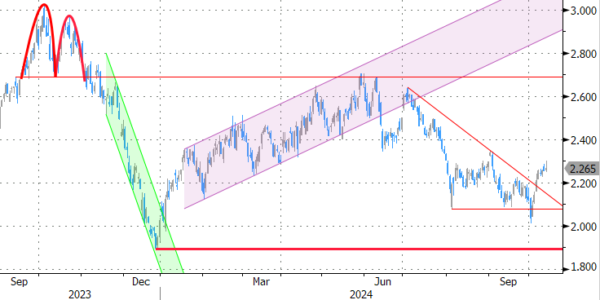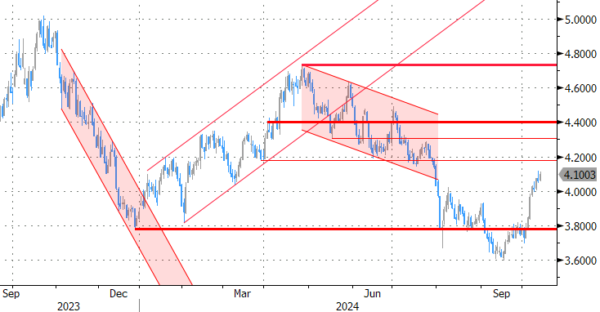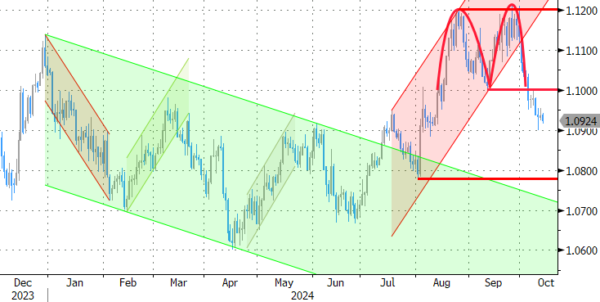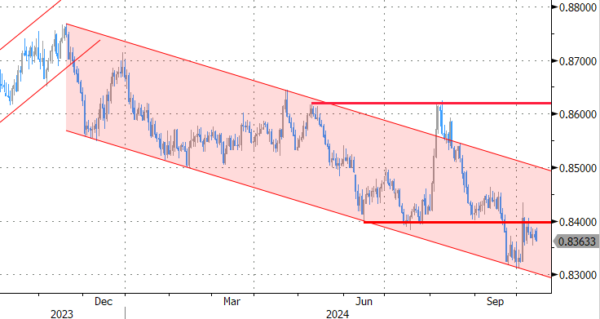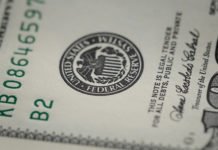Markets
The US yield curve finished last week with a little steepening. Net daily changes varied between -0.2 bps (2-yr) to +5.2 bps (30-yr), underpinned by second-tier data including decelerating and slightly below-consensus September PPIs. October consumer confidence (U. of Michigan) missed the bar as well. The headline index fell to 68.9 from 70.1 with both the current assessment and outlook deteriorating. The 1-yr ahead inflation gauge picked up from 2.7% to 2.9%, the 5-yr one eased as expected to 3%. German yields closed little changed due to a late-session swoon that erased much of the 4-5 bps gains earlier on the day. Major currencies were little changed against the dollar amid US markets sleepwalking into a long weekend. A healthy risk appetite (stocks 0.3-1% higher) was the main force pushing the likes of the NOK and SEK as well as cyclicals such as the Aussie & kiwi dollar a little higher. China’s yuan strengthened a bit in the run-up to a highly anticipated announced by the country’s finance minister on Saturday. After the economic planning agency underwhelmed earlier in the week, hopes ran high for Lan Fo’an to come big this time – to the tune of CNY 2tn. But while promising further steps to support the property sector and hinting at greater borrowing, investors were left in the dark by not putting a price tag on it. Chinese stock markets this morning trade volatile, swinging from gains to losses back to gains of currently 2.3% (CSI300). After the barrage of (pledged) fiscal and monetary measures in a short period of time, markets seem to give the government the benefit of the doubt. The need for a growth supporting policy pivot is increasingly apparent following another poor inflation reading for September. Consumer prices rose a mere 0.4%, undershooting the August-matching 0.6% consensus. Services inflation came in at only 0.2% y/y while core inflation barely stayed positive (0.1%, lowest since February 2021). Producer prices ventured deeper in negative territory (-2.8% from -1.8% and vs -2.6% expected). Factory inflation has been negative for two years straight (!) now. The yuan gapped lower at the open but pared losses in the meantime to USD/CNY 7.07. US markets are closed today for Columbus Day but a speech by Fed’s Waller on the economic outlook is worth watching. An otherwise empty European calendar paves the way for technically insignificant trading ahead of other events this week, including the ECB policy meeting. A 25 bps cut which was ruled out after the September meeting is now all but certain after disastrous PMIs and inflation numbers confirming ongoing disinflation.
News & Views
Rating agency Moody’s late Friday affirmed Belgium’s credit rating at Aa3 but changed the outlook from stable to negative. The rating agency said the decision to change the outlook reflects the risks that the next government will be unable to implement measures that would stabilize the government debt burden. According to Moody’s, the previous government made some small fiscal consolidation efforts, but they were not structural in nature. In the absence of a large fiscal consolidation programme, Moody’s says that debt will continue to rise due to the material structural increase in expenditures in recent years and persistent spending pressure. It expects the political economy of deficit and debt reduction may become more challenging in the future because of structural headwinds to fiscal consolidation. A large fiscal consolidation effort will require effort at all levels of government. In this respect Moody’s says that Belgium lacks intergovernmental coordination mechanisms to achieve this effort.
Rating agency Fitch on Friday cut the outlook on France’s rating from stable to negative. It affirmed the country’s rating at AA-. Moody’s sees a difficult fiscal policy ahead, as fiscal risks have increased since the previous review. This year’s projected fiscal slippage is placing the country in a worse starting position. Fitch expects wider deficits leading to a steep rise in debt toward 118.5% of GDP in 2028. High political fragmentation and a minority government complicate the country’s ability to deliver on sustainable fiscal consolidation. The government presented a sizeable package to bring the deficit to 5.0% of GDP by 2025 but some of the measures are temporary. All measures are worth €60 bn (or 2% of GDP) but the agency included only a part due to political uncertainty and implementation risks. The 2024 deficit is expected to widen to 6.1% GDP which exceeds Fitch’s forecast of 5.1%. Fitch raised the fiscal deficit for 2025 and 2026 to 5.4% and doesn’t expect the government to meet its revised deficit forecast to bring the deficit to 3.0% by 2029. Fitch expects the debt to GDP ratio to rise to 116.3% by end 2026.
Graphs
GE 10y yield
The ECB cut policy rates by 25 bps in June and in September. Stubborn inflation (core, services) still is a source of concern, but very weak PMI’s and soft comments of Lagarde (and other MPC members) suggest the ECB is likely to step up the pace of easing with an October cut. Spill-overs from strong US data prevented a test of the 2.0% barrier. 2.00-2.35% might serve as a ST consolidation range.
US 10-y yield
The Fed kicked off its easing cycle with a 50 bps move. Turning he focus from inflation to a potential slowdown in growth/employment made markets consider more 50 bps steps. Strong US September payrolls suggest the economy doesn’t need aggressive Fed support for now, but the debate might resurface as the economic cycle develops. 3.60% acted as strong support before a rebound (and resumption of the steepening trend) kicked in.
EUR/USD
EUR/USD twice tested the 1.12 big figure as the dollar lost interest rate support at stealth pace. Bets on fast and large rate cuts trumped traditional safe haven flows into USD. An ailing euro(pean economy) partially offset some of the general USD weakness. After solid early October US data, the dollar regained traction, with EUR/USD breaking the 1.1002 neckline. Targets of this pattern are near 1.08.
EUR/GBP
The BoE delivered a hawkish cut in August. Policy restrictiveness was indicated to be further unwound gradually. The economic picture between the UK and Europe also (temporarily?) diverged to the benefit of sterling, pulling EUR/GBP below 0.84 support. Dovish comments by BoE Bailey ended by default GBP-strength. Uncertainty on the UK budget to be released end this month is becoming an additional headwind for the UK currency.




